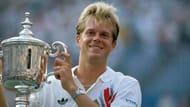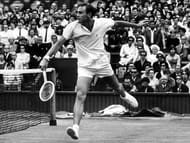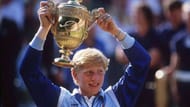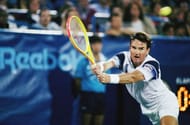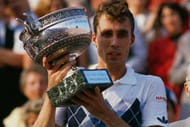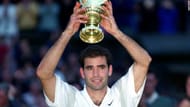Being World No.1 in any sport is a dream come true for any sportsperson. In tennis, there have been a number of eminent players who have been ranked World No.1 since the introduction of the ATP and WTA rankings. Many of these successful players have achieved the rare feat of a Career Slam by winning all four Grand Slam tournaments.
However, there have been a number of players who, despite being one of the best of their generation, have not been able to achieve this coveted feat. Here’s a list of seven Men’s players who haven’t been able to achieve the Career Grand Slam.
#7. Mats Wilander
The 1970s and 1980s was a golden age for tennis in Sweden as three players, Bjorn Borg, Mats Wilander and Stefan Edberg were among the premier dominants of World Tennis. Wilander was one of the finest players of his generation and held the World No.1 position for a total of 20 weeks and won a total of 33 titles including seven Grand Slam titles that included three Australian Open titles in 1983, 1984 and 1988, three French Open titles in 1982, 1985 and 1988, and US Open 1988.
He was the youngest player to win four Grand Slam titles and even though two of his Australian Open titles came when the tournament was held on grass courts, he was never able to clinch a single Wimbledon with his performances at the coveted event was relatively subdued with his best performances being consecutive quarter-final appearances from 1987-1989.In his first quarter-final appearance in 1987, he was up against 22-year old eleventh seeded Australian Pat Cash who beat him in straight sets. Cash eventually went on to surprisingly win the title by beating Ivan Lendl in the final.
The following year, Wilander was one of the favorites to win the title as he had won the Australian and French Opens earlier. In the quarter-finals he was up against future Olympic champion Miroslav Mecir.
The ninth-seeded Czech thrashed the second-seeded Wilander 6-3, 6-1, 6-3. In 1989, he faced fifth seeded John McEnroe who beat him in four sets; this being the only Wimbledon quarter-final where Wilander won a set.
Wilander might be one of the most highly regarded players of his time but he was never able to lay his hands on the prestigious Wimbledon trophy.
#6. Stefan Edberg
Probably the best Swedish player of all-time after Bjorn Borg, Stefan Edberg was undoubtedly one of the best players of his generation. Being at the top of the rankings for a total of 72 weeks, Edberg was known for his serve and volley and was able to play best on fast-playing surfaces like grass.
Edberg won a total of six Grand Slam titles of which four came on grass surfaces.
His Grand Slam titles included two Australian Open titles in 1985 and 1987 (the tournament was held on grass courts on both occasions), two Wimbledon titles in 1988 and 1990, and as many US Open titles in 1991 and 1992.
The one trophy that eluded Edberg was the Roland Garros – despite the fact that he reached the final in 1989.Edberg was the third seed ahead of the tournament and was not expected to do very well as he had a subdued quarter-final appearance at the Australian Open and was forced to miss a couple of tournaments owing to injuries.
After a shaky start in the first round, Edberg did not drop a single set before the semi-finals. In the final, Edberg faced 15th seeded 17-year old Michael Chang who beat him in a thrilling five-setter.
That was his only appearance in a Roland Garros as in the following few years, the best Edberg could do was reach the quarter-finals in 1991 and 1993.
The French Open turned out to be Edberg’s only obstacle to completing a Career Slam.
#5. John Newcombe
The period between the 1950s and 1970s was an era where Australia dominated world tennis. The likes of Ken Rosewall, Rod Laver and Tony Roche were amongst the best players in the world of their respective generations. The last of the Australian players who dominated tennis was John Newcombe.
Known for his serve and volley, Newcombe is regarded to be one of the most complete and versatile players of all-time, having been ranked World No.1 in both Singles and Doubles which included seven Grand Slam Singles titles and 17 Doubles titles.
Being at the top of the ATP rankings for eight weeks, the only Grand Slam that eluded Newcombe was the French Open title with his best performance being reaching the quarter-finals in 1965 and 1969.In the 1965 Roland Garros, Newcombe was the eleventh seed and produced an upset by defeating 1963 finalist Pierre Darmon in the fourth round. In the quarter-finals, he was up against compatriot Fred Stolle.
Stolle beat the 22-year old 6-1, 7-5, 11-9 and eventually went on to win the tournament by triumphing over fellow-countryman Tony Roche in straight sets in the final.
He reached the quarter-finals again after four years, being the fourth seed and was up against Dutchman Tom Okker, who was one of only three non-Australians in the quarter-finals.
The match was a pretty exciting one that went on to five sets, with Okker being the victor. Newcombe may be regarded to be one of the finest players of all-time but his French Open performances were quite subdued compared to other majors and turned out to be the only Grand Slam which Newcombe was unable to win.
#4. Boris Becker
One of the greatest players of all-time, Boris Becker was renowned for his fast and well-placed serve. Even though he had established himself as one of the world’s top players during the late 80s, he didn’t attain the No. 1 ranking until 1991 which he would hold for a total of 12 weeks.
Becker won a total of 49 Singles titles which included six Grand Slam titles including two Australian open titles in 1991 and 1986, three Wimbledon titles in 1985, 1986 and 1989, and a US Open title in 1989.
The German former No. 1 was an exceptional player on grass and carpet courts but seldom struggled on clay courts; the French Open being the only Grand Slam that eluded him with his best performance being semi-final appearances in 1987, 1989 and 1991.During the 1987 tournament, Becker was the second seed and had made his maiden French Open semi-final after defeating the great Jimmy Connors in the quarter-finals.
In the semis, Becker was up against fourth-seeded Mats Wilander who comprehensively beat him 6-4, 6-1, 6-2. After a disappointing fourth round showing in 1988, Becker was once again the second seed in the 1989 tournament and did not have much tough competition throughout the tournament when he faced a Swede for the second consecutive time in the semi-finals.
This time it was Stefan Edberg who beat him in a nail-biting five setter by the scoreline 6-3, 6-4, 5-7, 3-6, 6-2. He had a horrific performance at the 1990 tournament, being ousted in the opening round before reaching a third Roland Garros semi-final the following year. ‘
After ousting reigning champion Michael Chang in the quarter-finals, the second-seeded Becker was up against fourth-seeded Andre Agassi in the semis. Agassi beat him in four sets to end his hopes of a Career Slam.
That was the last when Becker reached the semi-finals of Roland Garros as he only took part in two other editions of the tournament, being ousted in the second round in 1993, and in the third round in 1995.
#3. Jimmy Connors
Regarded to be one of the greatest players in the history of the sport, Jimmy Connors was known for his powerful two-handed backhand and his service return. Connors was World No. 1 for a then-record 160 consecutive weeks and a total of 268 weeks overall.
Having won 109 Career Singles titles, Connors won eight Grand Slam Singles titles that included an Australian Open in 1974, two Wimbledon titles in 1974 and 1982, and five US Open titles in 1974, 1976, 1978, 1982 and 1983.
However, the one Grand Slam that eluded him was the French Open with his best performance being semi-final appearances in 1979, 1980, 1984 and 1985.The 1979 Roland Garros was the first edition of the Roland Garros where Connors had crossed the second round. The second seeded Connors was up against unseeded Paraguayan Victor Pecci in the semis who beat him in four sets.
The following year, Connors again reached the semi-finals; this time seeded third in the competition. In the semis, Connors faced 1977 Australian Open champion Vitas Gerulaitis. The match was a highly contested battle which lasted for five sets with the Lithuanian-American triumphing over Connors 6-1, 3-6, 6-7, 6-2, 6-4.
After three successive quarter-final appearances in the following years, Connors reached his third French Open semi-final in 1984 where he faced top-seeded John McEnroe. McEnroe comprehensively beat him in straight sets.
His last appearance at a Roland Garros semi-final came in 1985.
This time, Connors faced defending champion Ivan Lendl in the semi-finals who thrashed him 6-2, 6-3, 6-1. Even though Connors won the US Open when it was played on clay court once, he was never able to produce his best at the French Open which eventually denied him a Career Slam.
#2. Ivan Lendl
One of the greatest players not to have completed a Career Slam, Ivan Lendl’s numbers speak for themselves. Known for his heavy topspin from the baseline, Lendl was World No.1 for a total of 270 weeks and won 94 Career Titles including eight Grand Slam titles; two Australian Open titles in 1989 and 1990, three French Open titles in 1984, 1986 and 1987, and three consecutive US Open titles from 1985-1987.
Lendl is probably the greatest player not to have won a Wimbledon title, having lost two successive finals in 1986 and 1987.After a brilliant showing at the French Open which he won, Lendl was seeded first at Wimbledon and was arguably the tournament’s heaviest favorite. After two grueling matches in the quarter-finals and the semi-finals, Lendl locked horns with 18-year old reigning champion Boris Becker. Becker was clearly the better player of the day and won the match in straight sets.
Lendl was once again the favorite in 1987 and this time, coming into the final, his chances were pretty good, especially with his biggest adversary Boris Becker out of the tournament. The second seeded Lendl faced 11th seeded Australian Pat Cash in the final.
However, once again Lendl was beaten in straight sets. Although he won three more Grand Slams after the 1987 Wimbledon, Lendl was never able to reach another Wimbledon final. Although he’s one of the all-time legends of the sport, Lendl will surely be ruing his missed opportunities to capture the Wimbledon crown in 1986 and 1987.
#1. Pete Sampras
And Surprise, Surprise! As hard to believe it, Pete Sampras did not complete a Career Grand Slam. Known for his accurate serve, Sampras was at the top of the ATP rankings for a total of 286 weeks.
Sampras won a total of 64 career titles during his career including a then-record of fourteen Grand Slam Singles titles that consisted of two Australian Open titles in 1994 and 1997, a joint-record of seven Wimbledon titles in 1993, 1994, 1995, 1997, 1998, 1999 and 2000, and five US Open titles 1990, 1993, 1995, 1996, 2002.
However, as seen with many top players such as Jimmy Connors, Boris Becker and Stefan Edberg, “Pistol Pete” was never able to capture a single French Open throughout his career with his best performance being a semi-final appearance in 1996.Clay was Sampras’ worst surface and his performances at the surface were relatively subdued. Despite a disappointing showing at the Australian Open, Sampras was seeded first at the French Open and reached his first Roland Garros semi-final after beating two-time champion Jim Courier in a tough five-set quarter-final.
However, his semi-final opponent Yevgeny Kafelnikov was just too much for him as the Russian beat Sampras 7-6, 6-0, 6-2. Kafelnikov later went on to win the tournament by defeating German Michael Stich in the final, thus winning his first of two Grand Slam titles.
Sampras, however, wasn’t even to cross the third round ever since and still remains one of the greatest players not to have achieved a Career Slam.
